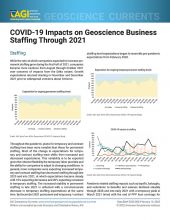Of all participants in the Geoscience COVID-19 Impacts study, recent geoscience graduates have been the most vulnerable to employment disruptions during the pandemic. However, the study results indicate that the most recent geoscience graduates have either remained employed or gained employment during the pandemic, with the majority of recent graduates employed in non-academic geoscience occupations.
Circle sizes are proportional to the distribution of recent graduates across occupational statuses. The width of the arrows is proportional to the percentage of graduates in a specific occupational status moving to another occupational status.
In the figure above, the movement of recent graduates between occupational statuses between February 2020 and March 2022 is demonstrated. Circles represent the reported occupational status of recent graduates, with the lighter outlined circles representing the first recorded status and the darker outlined circles representing the most recent reported status. Arrows indicate the flow of recent graduates between occupational statuses with the width of the arrows indicating the relative percentage of transfers from each specific occupational category.
Over the study period, students have moved across a range of occupational statuses, with about half moving temporarily into the unemployed category, before gaining employment. Recent graduates in post-doctoral positions primarily moved into faculty positions at universities and colleges. Of note is the flows between academic faculty and K-12 faculty occupations, much of which are individuals holding dual appointments at both K-12 and universities/colleges.
Geoscience graduates who earned their degrees between 2014 and 2018 continue to have the most stable employment situation of all recent geoscience graduate cohorts, with at least 90% of graduates employed or enrolled in a degree program between February 2020 and March 2022. As the pandemic took hold in early 2020, there was a steady increase in graduates from this cohort returning to school. By March 2022, 11% of this cohort’s graduates were enrolled in a geoscience degree program.
Employment of recent graduates who earned their degrees between 2019 and 2021 has steadily increased since 2020. Peaks in unemployment were concurrent with the shutdown of the economy in 2020 as well as with summer graduations. The peak in unemployment in December 2021 and January 2022 may be indicative of students who delayed summer graduation to finish in the Fall 2021 term. Peaks in employment activities among non-academic geoscience professions also track geoscience employer hiring activity which picked up during late 2021. By March 2022, 87% of graduates in this cohort were employed and 10% were enrolled in a degree program.
We will continue to provide current snapshots on the impacts of COVID-19 on the geoscience enterprise throughout the year. For more information, and to participate in the study, please visit: www.americangeosciences.org/workforce/covid19
Funding for this project is provided by the National Science Foundation (Award #2029570). The results and interpretation of the survey are the views of the American Geosciences Institute and not those of the National Science Foundation.










